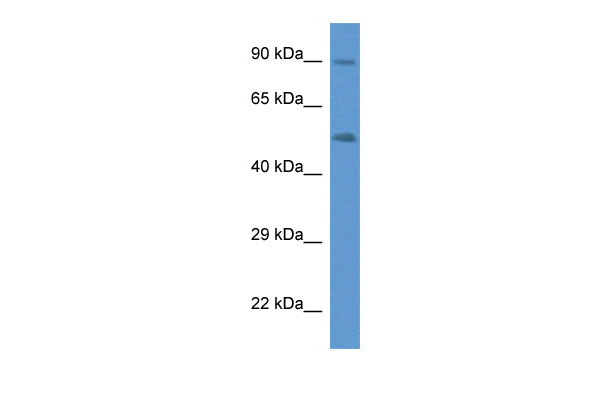CYP2W1 antibody - C-terminal region
Rabbit Polyclonal Antibody
- 产品详情
- 实验流程
Application
| WB |
|---|---|
| Primary Accession | Q8TAV3 |
| Other Accession | NM_017781, NP_060251 |
| Reactivity | Human, Rat, Pig, Dog, Horse, Bovine |
| Predicted | Human, Pig, Dog, Bovine |
| Host | Rabbit |
| Clonality | Polyclonal |
| Calculated MW | 53844 Da |
| Gene ID | 54905 |
|---|---|
| Alias Symbol | MGC34287 |
| Other Names | Cytochrome P450 2W1, 1.14.14.-, CYPIIW1, CYP2W1 |
| Format | Liquid. Purified antibody supplied in 1x PBS buffer with 0.09% (w/v) sodium azide and 2% sucrose. |
| Reconstitution & Storage | Add 50 ul of distilled water. Final anti-CYP2W1 antibody concentration is 1 mg/ml in PBS buffer with 2% sucrose. For longer periods of storage, store at 20°C. Avoid repeat freeze-thaw cycles. |
| Precautions | CYP2W1 antibody - C-terminal region is for research use only and not for use in diagnostic or therapeutic procedures. |
| Name | CYP2W1 {ECO:0000303|PubMed:26936974, ECO:0000312|HGNC:HGNC:20243} |
|---|---|
| Function | A cytochrome P450 monooxygenase that may play a role in retinoid and phospholipid metabolism (PubMed:22591743, PubMed:26936974). Catalyzes the hydroxylation of saturated carbon hydrogen bonds. Hydroxylates all trans-retinoic acid (atRA) to 4- hydroxyretinoate and may regulate atRA clearance. Other retinoids such as all-trans retinol and all-trans retinal are potential endogenous substrates (PubMed:26936974). Catalyzes both epoxidation of double bonds and hydroxylation of carbon hydrogen bonds of the fatty acyl chain of 1-acylphospholipids/2-lysophospholipids. Can metabolize various lysophospholipids classes including lysophosphatidylcholines (LPCs), lysophosphatidylinositols (LPIs), lysophosphatidylserines (LPSs), lysophosphatidylglycerols (LPGs), lysophosphatidylethanolamines (LPEs) and lysophosphatidic acids (LPAs) (PubMed:22591743). Has low or no activity toward 2-acylphospholipids/1-lysophospholipids, diacylphospholipids and free fatty acids (PubMed:22591743, PubMed:26936974). May play a role in tumorigenesis by activating procarcinogens such as aflatoxin B1, polycyclic aromatic hydrocarbon dihydrodiols and aromatic amines (PubMed:16551781, PubMed:20805301, PubMed:24278521). Mechanistically, uses molecular oxygen inserting one oxygen atom into a substrate, and reducing the second into a water molecule, with two electrons provided by NADPH via cytochrome P450 reductase (CPR; NADPH-ferrihemoprotein reductase) (PubMed:22591743, PubMed:26936974). |
| Cellular Location | Endoplasmic reticulum lumen. Cell membrane. Microsome membrane. Note=About 8% are expressed on the cell surface. |
| Tissue Location | Very low levels are detected in fetal and adult tissues. Highly expressed in several tumor samples, in particular colon and adrenal tumors. |
Research Areas
For Research Use Only. Not For Use In Diagnostic Procedures.
Application Protocols
Provided below are standard protocols that you may find useful for product applications.
REFERENCES
Hillier L.W.,et al.Nature 424:157-164(2003).
Karlgren M.,et al.Biochem. Biophys. Res. Commun. 341:451-458(2006).
Wu Z.L.,et al.Mol. Pharmacol. 69:2007-2014(2006).
Gomez A.,et al.Mol. Pharmacol. 78:1004-1011(2010).
Eun C.Y.,et al.Toxicol. Res. 26:171-175(2010).
终于等到您。ABCEPTA(百远生物)抗体产品。
点击下方“我要评价 ”按钮提交您的反馈信息,您的反馈和评价是我们最宝贵的财富之一,
我们将在1-3个工作日内处理您的反馈信息。
如有疑问,联系:0512-88856768 tech-china@abcepta.com.























 癌症的基本特征包括细胞增殖、血管生成、迁移、凋亡逃避机制和细胞永生等。找到癌症发生过程中这些通路的关键标记物和对应的抗体用于检测至关重要。
癌症的基本特征包括细胞增殖、血管生成、迁移、凋亡逃避机制和细胞永生等。找到癌症发生过程中这些通路的关键标记物和对应的抗体用于检测至关重要。 为您推荐一个泛素化位点预测神器——泛素化分析工具,可以为您的蛋白的泛素化位点作出预测和评分。
为您推荐一个泛素化位点预测神器——泛素化分析工具,可以为您的蛋白的泛素化位点作出预测和评分。 细胞自噬受体图形绘图工具为你的蛋白的细胞受体结合位点作出预测和评分,识别结合到自噬通路中的蛋白是非常重要的,便于让我们理解自噬在正常生理、病理过程中的作用,如发育、细胞分化、神经退化性疾病、压力条件下、感染和癌症。
细胞自噬受体图形绘图工具为你的蛋白的细胞受体结合位点作出预测和评分,识别结合到自噬通路中的蛋白是非常重要的,便于让我们理解自噬在正常生理、病理过程中的作用,如发育、细胞分化、神经退化性疾病、压力条件下、感染和癌症。






